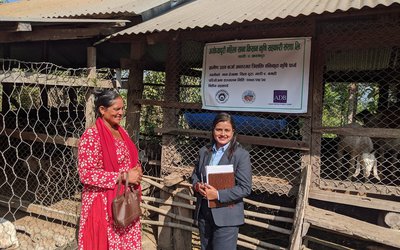
With the spread of COVID-19, schools are still under a lockdown even after seven months. Despite efforts to start classes online, they are unable to cover all due to lack of equipment, such as computers. Thus, children in Nepal have been suffering a lot.
A recently published report of UNICEF showed that anxiety and depression are the most common functional difficulties reported amongst children in Nepal due to obstruction of various activities including teaching and learning.
According to UNICEF, 1 in 12 children aged 10-14 years and 1 in 10 aged 15-17 years experience anxiety, and 2 per cent of 10-17-year olds suffer from depression.
To mark the World Children’s Day on 20 November, various programs were organized to highlight the issues around children’s and young people’s wellbeing. UNICEF Nepal hosted a virtual children’s parliamentary session and a virtual festival of visions and voices of young people. In addition, UNICEF Nepal is launching a mental health campaign ‘Ma Chhu Ni’ to help to build an allyship among young people.
Of particular concern during the COVID-19 pandemic and consequent lockdown is the mental health of children and young people. Beyond their immediate experiences, mental health issues and distress can have a lasting impact on children’s long-term development and the current pandemic has exposed the extent and severity of the global mental health crisis.
Children and adolescents account for 1 in 9 of reported COVID-19infections, according to a new analysis released ahead of World Children’s Day
UNICEF warned in a new report of significant and growing consequences for children as the COVID-19 pandemic lurches toward a second year.
Released ahead of World Children’s Day, Averting a Lost COVID Generation is the first UNICEF report to comprehensively outline the dire and growing consequences for children as the pandemic drags on. It shows that while symptoms among infected children remain mild, infections are rising and the longer-term impact on the education, nutrition and well-being of an entire generation of children and young people can be life-altering.
“Throughout the COVID-19 pandemic there has been a persistent myth that children are barely affected by the disease. Nothing could be further from the truth,” said Henrietta Fore, UNICEF Executive Director. “While children can get sick and can spread the disease, this is just the tip of the pandemic iceberg. Disruptions to key services and soaring poverty rates pose the biggest threat to children. The longer the crisis persists, the deeper its impact on children’s education, health, nutrition and well-being. The future of an entire generation is at risk.”
The report finds that, as of 3 November, in 87 countries with age-disaggregated data, children and adolescents under 20 years of age accounted for 1 in 9 of COVID-19 infections, or 11 per cent of the 25.7 million infections reported by these countries. More reliable, age-disaggregated data on infection, deaths and testing is needed to better understand how the crisis impacts the most vulnerable children and guide the response.
While children can transmit the virus to each other and to older age groups, there is strong evidence that, with basic safety measures in place, the net benefits of keeping schools open outweigh the costs of closing them, the report notes. Schools are not a main driver of community transmission, and children are more likely to get the virus outside of school settings.
COVID-related disruptions to critical health and social services for children pose the most serious threat to children, the report says.
Using new data from UNICEF surveys across 140 countries, it notes that: Around one-third of the countries analyzed witnessed a drop of at least 10 per cent in coverage for health services such as routine vaccinations, outpatient care for childhood infectious diseases, and maternal health services. Fear of infection is a prominent reason.
There is a 40 per cent decline in the coverage of nutrition services for women and children across 135 countries. As of October 2020, 265 million children were still missing out on school meals globally. More than 250 million children under 5 could miss the life-protecting benefits of vitamin A supplementation programmes.
65countries reported a decrease in home visits by social workers in September 2020, compared to the same time last year.
More alarming data from the report include: As of November 2020, 572 million students are affected across 30 country-wide school closures – 33 per cent of the enrolled students worldwide.
An estimated 2 million additional child deaths and 200,000 additional stillbirths could occur over a 12-month period with severe interruptions to services and rising malnutrition.
An additional 6 to 7 million children under the age of 5 will suffer from wasting or acute malnutrition in 2020, a 14 per cent rise that will translate into more than 10,000 additional child deaths per month – mostly in sub-Saharan Africa and South Asia.
Globally, the number of children living in multidimensional poverty – without access to education, health, housing, nutrition, sanitation or water – is estimated to have soared by 15 per cent, or an additional 150 million children by mid-2020.
To respond to this crisis, UNICEF is calling on governments and partners to: Ensure all children learn, including by closing the digital divide.
Guarantee access to nutrition and health services and make vaccines affordable and available to every child.
Support and protect the mental health of children and young people and bring an end to abuse, gender-based violence and neglect in childhood.
Increase access to safe drinking water, sanitation and hygiene and address environmental degradation and climate change.
Reverse the rise in child poverty and ensure an inclusive recovery for all. Redouble efforts to protect and support children and their families living through conflict, disaster and displacement.
“This World Children’s Day, we are asking governments, partners and the private sector to listen to children and prioritize their needs,” Fore said. “As we all reimagine the future and look ahead toward a post-pandemic world, children must come first.”
- PM Oli's Visit To China: Geopolitical Implications
- Nov 19, 2024
- NEA: Kul Man Ghising, A Cool Man
- Oct 28, 2024
- DASHAIN FESTIVAL : Festival of Unity
- Oct 04, 2024
- NEPAL-CANADA Bilateral Meeting
- Oct 04, 2024
- MIDDLE BHOTEKOSHI: Final Stage
- Sep 23, 2024
















